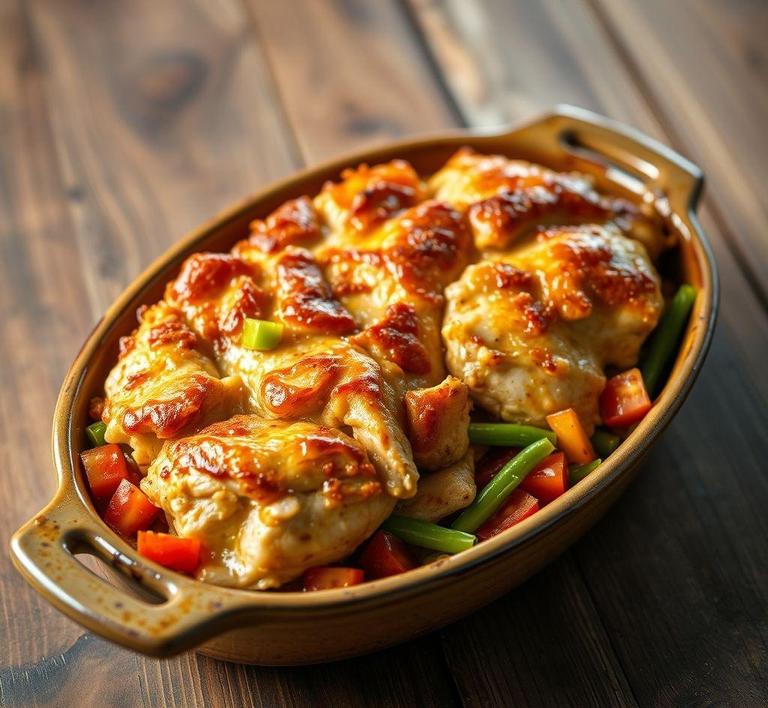If you’ve ever found yourself with leftovers from a delicious chicken casserole but aren’t sure if it’s safe to refreeze, you’re not alone! The good news is, it can be done, but there are a few important guidelines to follow to ensure your casserole stays tasty and safe to eat. Refreezing chicken casserole involves understanding how to properly store and reheat it, as well as knowing how long it can sit in the freezer without compromising quality. In this guide, we’ll walk you through the ins and outs of refreezing your chicken casserole, from initial storage to the best reheating methods, so you can enjoy those leftovers with confidence!
Can You Refreeze Chicken Casserole?

Yes, you can refreeze chicken casserole – but with a few very important caveats. Whether it’s a creamy chicken and rice bake, a cheesy enchilada casserole, or a classic pot pie, the key factor that determines whether your casserole is safe to refreeze hinges on how it was handled after its first thaw.
If the chicken casserole was thawed in the refrigerator and has been kept at a safe temperature (below 40°F/4°C) without spending more than 2 hours at room temperature, it is generally safe to refreeze. However, if the casserole was thawed on the countertop, or if it has been sitting out for more than two hours, refreezing it is not recommended due to the increased risk of bacterial growth.
Moreover, the ingredients in the casserole also play a role. Chicken itself is highly perishable and, once cooked, should be handled carefully. Dishes with dairy (like creamy sauces or cheese), rice (which is susceptible to Bacillus cereus), or eggs may degrade faster in quality or become unsafe more quickly.
How To Refreeze Chicken Casserole?
If you’ve ensured that your chicken casserole meets the food safety criteria (i.e., thawed properly in the refrigerator and not left at room temperature), you can follow these steps to refreeze it safely:
-
Cool It Quickly (if recently cooked again):
If you’ve reheated the casserole and now want to refreeze leftovers, allow it to cool down promptly. To speed up cooling:
- Divide the casserole into smaller, shallow containers.
- Place the containers in an ice bath or in front of a fan to drop the temperature swiftly.
-
Use Airtight Containers or Heavy-Duty Freezer Bags:
To minimize freezer burn and protect against unwanted moisture loss or contamination, store the casserole in airtight containers or heavy-duty, freezer-safe plastic bags. If freezing individual portions, wrap them tightly in plastic wrap and then foil for double protection.
-
Label and Date:
Always mark your container or bag with the name of the dish and the date it’s being refrozen. While you can technically store it for months, aim to consume it within 1 to 2 months for optimal quality and taste.
-
Freeze Promptly:
Place the container in the coldest part of your freezer. Don’t stack warm or recently thawed items – doing so can raise the internal temperature of surrounding foods, putting them at risk.
Quality Impact
While refreezing chicken casserole is safe under the right conditions, it can have a noticeable impact on the dish’s texture, flavor, and overall quality. Here’s how:
-
Texture Changes:
Every freeze-thaw cycle causes the formation of ice crystals within the food. These crystals rupture the structure of vegetables, pasta, and proteins, leading to a mushier consistency upon reheating. Cream-based sauces can separate or curdle, and rice may become dry or overly soft.
-
Flavor Degradation:
Refreezing can slightly dull the flavors of herbs and spices. Chicken might lose some of its savory punch, and sauces can taste flatter or watered down.
-
Moisture Loss:
Freezer burn – caused by air exposure – can lead to dry patches and unpleasant textures. Even with proper packaging, moisture levels will inevitably decrease the second time around.
-
Layer Separation:
Casseroles with multiple components (e.g., a breadcrumb topping, a creamy middle, and a veggie-chicken base) may lose their cohesion and become a bit disjointed in consistency. The topping may turn soggy, and the sauce may no longer bind the ingredients as intended.
While the dish will still be safe to eat, especially if reheated to an internal temperature of 165°F (74°C), it might not be as satisfying as the original version.
Refreezing chicken casserole is not just a question of practicality – it’s a delicate balancing act between safety and quality. If the casserole was thawed correctly in the fridge and hasn’t spent time in the danger zone (40°F-140°F), then it is generally safe to refreeze. However, keep in mind that each freeze-thaw cycle exacts a toll on the dish’s texture, flavor, and moisture content.
For best results, try to freeze portions that you’re confident you’ll consume in one sitting. If you anticipate leftovers, consider freezing smaller, individual servings rather than refreezing an entire casserole dish multiple times. This minimizes waste, maintains quality, and ensures every portion is as delicious as the first.
Is It Safe To Refreeze Chicken Casserole?
The question of whether it’s safe to refreeze chicken casserole is a nuanced one, heavily dependent on how the casserole has been handled since it was first prepared and thawed. In general, it is safe to refreeze chicken casserole under the right conditions. The key factors to consider are time, temperature, and exposure to contaminants.
If the casserole was thawed in the refrigerator and has been kept at or below 40°F (4°C), it can be safely refrozen within 2-3 days. This is because the cold temperature slows bacterial growth significantly, preserving the food’s integrity and safety. However, if the casserole was left at room temperature for more than two hours-or one hour if the room was hotter than 90°F (32°C)-it falls into the “danger zone”, where bacteria like Salmonella and Listeria can multiply rapidly. In such cases, refreezing becomes unsafe and can pose a serious health risk.
Furthermore, each freeze-thaw cycle causes structural changes in the food. Ice crystals formed during freezing can rupture cell walls in the chicken and vegetables, leading to a mushier texture when reheated. While refreezing doesn’t necessarily make the casserole unsafe if done properly, it can compromise taste, moisture, and overall quality.
Signs That Chicken Casserole Should Not Be Refrozen
Even when food safety guidelines are technically met, some signs indicate that your chicken casserole should not be returned to the freezer. Pay close attention to the following warning signs:
-
Unpleasant Odor:
If your casserole emits a sour, sulfurous, or generally off smell-even slightly-it’s a strong indicator that bacterial spoilage has begun. Trust your nose; it’s one of your best tools for food safety.
-
Discoloration:
A healthy chicken casserole should retain its natural colors-whitish-pink chicken, vibrant vegetables, and creamy or golden sauces. If you notice gray patches on the meat or dull, greenish hues in the sauce, spoilage is likely.
-
Slimy or Sticky Texture:
While casseroles are naturally moist, a slimy film across the surface or an oddly sticky consistency signals microbial growth. This texture change is a red flag and a sure sign the dish should not be refrozen.
-
Previous Improper Handling:
If you’re unsure how the casserole was stored-perhaps it sat on a potluck table all afternoon, or was left out overnight-it’s best not to risk refreezing. Food safety hinges on certainty.
Common Refreezing Mistakes
Even the most seasoned home cooks can make missteps when it comes to freezing and refreezing prepared meals. Here are some of the most frequent mistakes to watch out for:
-
Refreezing After Microwave Thawing:
Using a microwave to thaw is convenient, but it often creates uneven heating, with some parts entering the danger zone. If a casserole has been partially cooked during microwave thawing, it should be eaten immediately and never refrozen.
-
Not Using Airtight Containers:
Improper storage exposes food to freezer burn and cross-contamination. Always use airtight containers or vacuum-sealed bags to maintain quality and safety.
-
Forgetting to Label:
Without clear labels including the date of preparation and freezing, you risk keeping food beyond its safe or tasty shelf life. Refreezing old food only prolongs its decline.
-
Multiple Refreezing Cycles:
Continually freezing and thawing a casserole greatly diminishes its taste and texture, and increases the likelihood of bacterial growth. Aim to refreeze only once, and only when it’s truly necessary.
Tips And Tricks
To safely refreeze chicken casserole while maintaining its flavor and safety, follow these practical guidelines:
-
Portion Before Freezing:
Divide the casserole into individual or meal-sized portions before the initial freeze. This way, you can thaw only what you need, reducing waste and avoiding multiple thaw-refreeze cycles.
-
Cool Completely Before Freezing:
Always allow the casserole to cool to room temperature (within 1-2 hours of cooking) before freezing. Placing hot food in the freezer can raise the freezer’s internal temperature and endanger other stored items.
-
Use a Blast Chill or Ice Bath:
To speed up cooling and prevent bacteria from multiplying, use an ice bath or shallow containers to rapidly lower the food’s temperature before freezing.
-
Label Clearly:
Mark containers with the contents, date cooked, and date frozen. If refreezing, make a second note. This helps you track freshness and manage your freezer inventory efficiently.
-
Reheat Thoroughly:
When reheating previously frozen (and possibly refrozen) chicken casserole, ensure it reaches an internal temperature of 165°F (74°C). This step is critical to kill any bacteria that may have developed.
Conclusion
Refreezing chicken casserole isn’t inherently unsafe, but it demands careful handling and vigilance. The cornerstone of food safety lies in maintaining proper temperatures, avoiding cross-contamination, and knowing when a dish is past its prime. While refreezing may slightly alter the casserole’s texture or flavor, it can be done safely under the right circumstances.
By staying attentive to storage conditions and spoilage indicators, and by embracing smart food preservation techniques, you can extend the life of your home-cooked meals while safeguarding your health and taste buds. So, the next time you’re faced with leftovers, don’t panic-just be informed, cautious, and organized. Your freezer can be your friend, but only if you use it wisely.


